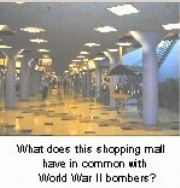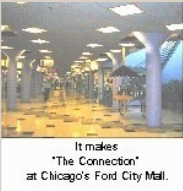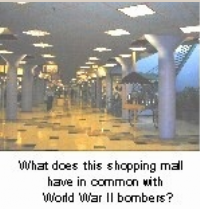







That's when a visionary developer bought the complex and turned it into Ford City, an urban shopping mall, with two above-grade sections connected by an underground tunnel (Peacock Alley) with retail spaces. The center quickly became successful. In 1987, Equity Properties and Development Company bought the mall and redeveloped that lower-level area, not only enhancing its internal character but also creating a more inviting entrance from the main mall. Now called "The Connection," this tunnel is a colorful, brightly lit retail corridor featuring 50,000 square feet of space apportioned among 20 stores offering nail, hair, and massage services as well as products including art, clothing, cigars, and collectibles. Another fortified tunnel is being used as a merchandise storage and processing area for one of the mall's department store anchors.
Corporate
In Benicia, California, between San Francisco and Sacramento, a retired Navy armament bunker was recently refurbished into a stylish corporate headquarters. The December 2000 issue of Contract magazine describes the transformation orchestrated by the interior design firm Simon Martin-Vegue Winkelstein Moris. Premium Tobacco Stores Inc. had used the bunker as a warehouse before deciding to convert it into the company's 8,500-square-foot office complex. Sunlight was introduced into the space via skylights bored through the 20-inch-thick concrete roofs. Direct and indirect artificial lights add general illumination and highlight interior design elements and art objects. Rather than trying to disguise the bunker's pragmatic form, the renovation accented the arched-roof structure and the sandblasted, 3-foot-thick concrete walls. The leader of the design team credits the appealing results with helping the firm land a prized contract to design the interiors of American Airlines planes.
Environmental
It's not as aesthetically appealing, but an abandoned Nazi bunker system in Poland is serving an important ecological purpose. The 18-mile-long system, buried 100-164 feet below ground and extending over a 9-square-mile area, was not quite completed when World War II ended. Occasional doorways and a series of vertical air shafts connect the sprawling system with the surface. During decades of disuse, the damp, dark, quiet spaces attracted increasing numbers of bats that migrated from surrounding areas each fall to hibernate in the abandoned bunkers and tunnels. Intensive use of artificial fertilizers in the area since 1950 took a heavy toll on the bat population. After the government stopped requiring the use of such chemicals in the 1980s, the bunker system provided a hospitable habitat that helped replenish the population of the insect-eating, flying mammals. Each year, at least 30,000 bats hibernate in the labyrinth--a number that is estimated to represent 90 percent of Poland's winter population of the valuable but misunderstood creatures. The Polish government has declared the bunkers to be a protected area known as the Nietoperek Bat Nature Reserve.
Tourist
Several World War II underground complexes have been opened for public tours in recent years. The following examples are among them:
In World War II's Pacific theater, the Philippine island of Corregidor hosted two legendary battles. In 1942 Japanese forces prevailed, and in 1945 Allied forces regained control. The mile-long Malinta Tunnel was a formidable element in the defense of the island. Housed in its 835-foot-long, 24-foot-wide expanse were an arsenal, a hospital, and a command headquarters. Tour groups arrive by ferry boat from Manila to explore the island and its subterranean stronghold.
On the English Channel island of Jersey, a nearly completed German Underground Hospital is open daily from mid-March through early November and then twice a week until mid-December. Two-thirds of a mile long, the system of tunnels and chambers were blasted and carved out of rock and then lined with concrete. When construction began in 1941, this Nazi installation was intended to be an artillery barracks and munitions store. As the tide of war turned and D-Day approached, however, it was turned into a medical facility to treat battle casualties.
Under London, Churchill's Cabinet War Rooms were kept secret until 1981. After three years of restoration work, they were opened as a museum. They can also be rented for meetings, corporate dinners, and festive receptions.
Corporate
In Benicia, California, between San Francisco and Sacramento, a retired Navy armament bunker was recently refurbished into a stylish corporate headquarters. The December 2000 issue of Contract magazine describes the transformation orchestrated by the interior design firm Simon Martin-Vegue Winkelstein Moris. Premium Tobacco Stores Inc. had used the bunker as a warehouse before deciding to convert it into the company's 8,500-square-foot office complex. Sunlight was introduced into the space via skylights bored through the 20-inch-thick concrete roofs. Direct and indirect artificial lights add general illumination and highlight interior design elements and art objects. Rather than trying to disguise the bunker's pragmatic form, the renovation accented the arched-roof structure and the sandblasted, 3-foot-thick concrete walls. The leader of the design team credits the appealing results with helping the firm land a prized contract to design the interiors of American Airlines planes.
Environmental
It's not as aesthetically appealing, but an abandoned Nazi bunker system in Poland is serving an important ecological purpose. The 18-mile-long system, buried 100-164 feet below ground and extending over a 9-square-mile area, was not quite completed when World War II ended. Occasional doorways and a series of vertical air shafts connect the sprawling system with the surface. During decades of disuse, the damp, dark, quiet spaces attracted increasing numbers of bats that migrated from surrounding areas each fall to hibernate in the abandoned bunkers and tunnels. Intensive use of artificial fertilizers in the area since 1950 took a heavy toll on the bat population. After the government stopped requiring the use of such chemicals in the 1980s, the bunker system provided a hospitable habitat that helped replenish the population of the insect-eating, flying mammals. Each year, at least 30,000 bats hibernate in the labyrinth--a number that is estimated to represent 90 percent of Poland's winter population of the valuable but misunderstood creatures. The Polish government has declared the bunkers to be a protected area known as the Nietoperek Bat Nature Reserve.
Tourist
Several World War II underground complexes have been opened for public tours in recent years. The following examples are among them:
In World War II's Pacific theater, the Philippine island of Corregidor hosted two legendary battles. In 1942 Japanese forces prevailed, and in 1945 Allied forces regained control. The mile-long Malinta Tunnel was a formidable element in the defense of the island. Housed in its 835-foot-long, 24-foot-wide expanse were an arsenal, a hospital, and a command headquarters. Tour groups arrive by ferry boat from Manila to explore the island and its subterranean stronghold.
On the English Channel island of Jersey, a nearly completed German Underground Hospital is open daily from mid-March through early November and then twice a week until mid-December. Two-thirds of a mile long, the system of tunnels and chambers were blasted and carved out of rock and then lined with concrete. When construction began in 1941, this Nazi installation was intended to be an artillery barracks and munitions store. As the tide of war turned and D-Day approached, however, it was turned into a medical facility to treat battle casualties.
Under London, Churchill's Cabinet War Rooms were kept secret until 1981. After three years of restoration work, they were opened as a museum. They can also be rented for meetings, corporate dinners, and festive receptions.
Underground military installations played a major role in World War II. From Japan and the Philippine Islands to the European continent, tunnels and bunkers provided shelter, support services, work places, and storage space for soldiers and civilians. Prime Minister Winston Churchill, General Dwight Eisenhower, and General Douglas MacArthur commanded their armed forces from subterranean posts. So did Adolph Hitler--until he committed suicide in his underground command bunker. No battles were fought within the continental United States; nevertheless, underground structures were also built across the country to support the war effort. What has happened to those concrete-lined holes in the ground?
Some, of course, are still in use; active military bases need secure areas for munitions storage, for instance. Some were simply abandoned--left behind with no useful purpose foreseen. But a few have been revived to serve new functions. Here are some examples:
Retail
Like most US manufacturers, Ford Motor Company devoted its efforts to making war equipment between 1940 and 1945. Toward this effort, Ford built a 6-million-square-foot factory in Chicago, near the Chicago Municipal Airport (now Midway Airport), to build military aircraft engines. Two huge manufacturing buildings were above ground, but they were linked by two wide, bomb-proof tunnels. After brief post-war stints producing automobiles and then jet engines for the Korean Conflict, the factory languished. By the early 1960s, it was an empty hulk referred to by some as the "world's largest white elephant."
Some, of course, are still in use; active military bases need secure areas for munitions storage, for instance. Some were simply abandoned--left behind with no useful purpose foreseen. But a few have been revived to serve new functions. Here are some examples:
Retail
Like most US manufacturers, Ford Motor Company devoted its efforts to making war equipment between 1940 and 1945. Toward this effort, Ford built a 6-million-square-foot factory in Chicago, near the Chicago Municipal Airport (now Midway Airport), to build military aircraft engines. Two huge manufacturing buildings were above ground, but they were linked by two wide, bomb-proof tunnels. After brief post-war stints producing automobiles and then jet engines for the Korean Conflict, the factory languished. By the early 1960s, it was an empty hulk referred to by some as the "world's largest white elephant."

Home









Bargain Bunkers




Underground military installations played a major role in World War II. From Japan and the Philippine Islands to the European continent, tunnels and bunkers provided shelter, support services, work places, and storage space for soldiers and civilians. Prime Minister Winston Churchill, General Dwight Eisenhower, and General Douglas MacArthur commanded their armed forces from subterranean posts. So did Adolph Hitler--until he committed suicide in his underground command bunker. No battles were fought within the continental United States; nevertheless, underground structures were also built across the country to support the war effort. What has happened to those concrete-lined holes in the ground?
Some, of course, are still in use; active military bases need secure areas for munitions storage, for instance. Some were simply abandoned--left behind with no useful purpose foreseen. But a few have been revived to serve new functions. Here are some examples:
Some, of course, are still in use; active military bases need secure areas for munitions storage, for instance. Some were simply abandoned--left behind with no useful purpose foreseen. But a few have been revived to serve new functions. Here are some examples:









Retail
Like most US manufacturers, Ford Motor Company devoted its efforts to making war equipment between 1940 and 1945. Toward this effort, Ford built a 6-million-square-foot factory in Chicago, near the Chicago Municipal Airport (now Midway Airport), to build military aircraft engines. Two huge manufacturing buildings were above ground, but they were linked by two wide, bomb-proof tunnels. After brief post-war stints producing automobiles and then jet engines for the Korean Conflict, the factory languished. By the early 1960s, it was an empty hulk referred to by some as the "world's largest white elephant."
Like most US manufacturers, Ford Motor Company devoted its efforts to making war equipment between 1940 and 1945. Toward this effort, Ford built a 6-million-square-foot factory in Chicago, near the Chicago Municipal Airport (now Midway Airport), to build military aircraft engines. Two huge manufacturing buildings were above ground, but they were linked by two wide, bomb-proof tunnels. After brief post-war stints producing automobiles and then jet engines for the Korean Conflict, the factory languished. By the early 1960s, it was an empty hulk referred to by some as the "world's largest white elephant."
That's when a visionary developer bought the complex and turned it into Ford City, an urban shopping mall, with two above-grade sections connected by an underground tunnel (Peacock Alley) with retail spaces. The center quickly became successful. In 1987, Equity Properties and Development Company bought the mall and redeveloped that lower-level area, not only enhancing its internal character but also creating a more inviting entrance from the main mall. Now called "The Connection," this tunnel is a colorful, brightly lit retail corridor featuring 50,000 square feet of space apportioned among 20 stores offering nail, hair, and massage services as well as products including art, clothing, cigars, and collectibles. Another fortified tunnel is being used as a merchandise storage and processing area for one of the mall's department store anchors.
Corporate
In Benicia, California, between San Francisco and Sacramento, a retired Navy armament bunker was recently refurbished into a stylish corporate headquarters. The December 2000 issue of Contract magazine describes the transformation orchestrated by the interior design firm Simon Martin-Vegue Winkelstein Moris. Premium Tobacco Stores Inc. had used the bunker as a warehouse before deciding to convert it into the company's 8,500-square-foot office complex. Sunlight was introduced into the space via skylights bored through the 20-inch-thick concrete roofs. Direct and indirect artificial lights add general illumination and highlight interior design elements and art objects. Rather than trying to disguise the bunker's pragmatic form, the renovation accented the arched-roof structure and the sandblasted, 3-foot-thick concrete walls. The leader of the design team credits the appealing results with helping the firm land a prized contract to design the interiors of American Airlines planes.
Environmental
It's not as aesthetically appealing, but an abandoned Nazi bunker system in Poland is serving an important ecological purpose. The 18-mile-long system, buried 100-164 feet below ground and extending over a 9-square-mile area, was not quite completed when World War II ended. Occasional doorways and a series of vertical air shafts connect the sprawling system with the surface. During decades of disuse, the damp, dark, quiet spaces attracted increasing numbers of bats that migrated from surrounding areas each fall to hibernate in the abandoned bunkers and tunnels. Intensive use of artificial fertilizers in the area since 1950 took a heavy toll on the bat population. After the government stopped requiring the use of such chemicals in the 1980s, the bunker system provided a hospitable habitat that helped replenish the population of the insect-eating, flying mammals. Each year, at least 30,000 bats hibernate in the labyrinth--a number that is estimated to represent 90 percent of Poland's winter population of the valuable but misunderstood creatures. The Polish government has declared the bunkers to be a protected area known as the Nietoperek Bat Nature Reserve.
Tourist
Several World War II underground complexes have been opened for public tours in recent years. The following examples are among them:
In World War II's Pacific theater, the Philippine island of Corregidor hosted two legendary battles. In 1942 Japanese forces prevailed, and in 1945 Allied forces regained control. The mile-long Malinta Tunnel was a formidable element in the defense of the island. Housed in its 835-foot-long, 24-foot-wide expanse were an arsenal, a hospital, and a command headquarters. Tour groups arrive by ferry boat from Manila to explore the island and its subterranean stronghold.
On the English Channel island of Jersey, a nearly completed German Underground Hospital is open daily from mid-March through early November and then twice a week until mid-December. Two-thirds of a mile long, the system of tunnels and chambers were blasted and carved out of rock and then lined with concrete. When construction began in 1941, this Nazi installation was intended to be an artillery barracks and munitions store. As the tide of war turned and D-Day approached, however, it was turned into a medical facility to treat battle casualties.
Under London, Churchill's Cabinet War Rooms were kept secret until 1981. After three years of restoration work, they were opened as a museum. They can also be rented for meetings, corporate dinners, and festive receptions.
Corporate
In Benicia, California, between San Francisco and Sacramento, a retired Navy armament bunker was recently refurbished into a stylish corporate headquarters. The December 2000 issue of Contract magazine describes the transformation orchestrated by the interior design firm Simon Martin-Vegue Winkelstein Moris. Premium Tobacco Stores Inc. had used the bunker as a warehouse before deciding to convert it into the company's 8,500-square-foot office complex. Sunlight was introduced into the space via skylights bored through the 20-inch-thick concrete roofs. Direct and indirect artificial lights add general illumination and highlight interior design elements and art objects. Rather than trying to disguise the bunker's pragmatic form, the renovation accented the arched-roof structure and the sandblasted, 3-foot-thick concrete walls. The leader of the design team credits the appealing results with helping the firm land a prized contract to design the interiors of American Airlines planes.
Environmental
It's not as aesthetically appealing, but an abandoned Nazi bunker system in Poland is serving an important ecological purpose. The 18-mile-long system, buried 100-164 feet below ground and extending over a 9-square-mile area, was not quite completed when World War II ended. Occasional doorways and a series of vertical air shafts connect the sprawling system with the surface. During decades of disuse, the damp, dark, quiet spaces attracted increasing numbers of bats that migrated from surrounding areas each fall to hibernate in the abandoned bunkers and tunnels. Intensive use of artificial fertilizers in the area since 1950 took a heavy toll on the bat population. After the government stopped requiring the use of such chemicals in the 1980s, the bunker system provided a hospitable habitat that helped replenish the population of the insect-eating, flying mammals. Each year, at least 30,000 bats hibernate in the labyrinth--a number that is estimated to represent 90 percent of Poland's winter population of the valuable but misunderstood creatures. The Polish government has declared the bunkers to be a protected area known as the Nietoperek Bat Nature Reserve.
Tourist
Several World War II underground complexes have been opened for public tours in recent years. The following examples are among them:
In World War II's Pacific theater, the Philippine island of Corregidor hosted two legendary battles. In 1942 Japanese forces prevailed, and in 1945 Allied forces regained control. The mile-long Malinta Tunnel was a formidable element in the defense of the island. Housed in its 835-foot-long, 24-foot-wide expanse were an arsenal, a hospital, and a command headquarters. Tour groups arrive by ferry boat from Manila to explore the island and its subterranean stronghold.
On the English Channel island of Jersey, a nearly completed German Underground Hospital is open daily from mid-March through early November and then twice a week until mid-December. Two-thirds of a mile long, the system of tunnels and chambers were blasted and carved out of rock and then lined with concrete. When construction began in 1941, this Nazi installation was intended to be an artillery barracks and munitions store. As the tide of war turned and D-Day approached, however, it was turned into a medical facility to treat battle casualties.
Under London, Churchill's Cabinet War Rooms were kept secret until 1981. After three years of restoration work, they were opened as a museum. They can also be rented for meetings, corporate dinners, and festive receptions.

Unless otherwise attributed, all content is © Loretta Hall, 2000-2024.

Unless otherwise attributed, all SubsurfaceBuildings.com content is © Loretta Hall, 2000-2024.








